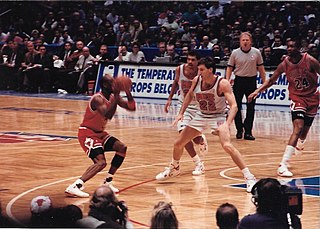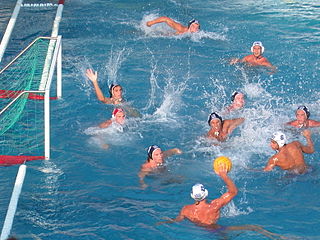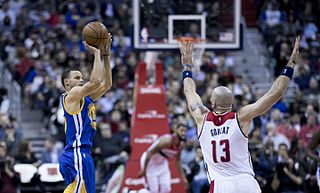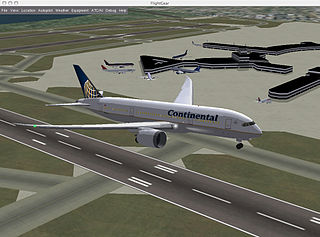
Basketball is a team sport in which two teams, most commonly of five players each, opposing one another on a rectangular court, compete with the primary objective of shooting a basketball through the defender's hoop, while preventing the opposing team from shooting through their own hoop. A field goal is worth two points, unless made from behind the three-point line, when it is worth three. After a foul, timed play stops and the player fouled or designated to shoot a technical foul is given one, two or three one-point free throws. The team with the most points at the end of the game wins, but if regulation play expires with the score tied, an additional period of play (overtime) is mandated.

Water polo is a competitive team sport played in water between two teams of seven players each. The game consists of four quarters in which the teams attempt to score goals by throwing the ball into the opposing team's goal. The team with the most goals at the end of the game wins the match. Each team is made up of six field players and one goalkeeper. Excluding the goalkeeper, players participate in both offensive and defensive roles. It is typically played in an all-deep pool where players cannot touch the bottom.
Simulation video games are a diverse super-category of video games, generally designed to closely simulate real world activities. A simulation game attempts to copy various activities from real life in the form of a game for various purposes such as training, analysis, prediction, or entertainment. Usually there are no strictly defined goals in the game, and the player is allowed to control a character or environment freely. Well-known examples are war games, business games, and role play simulation. From three basic types of strategic, planning, and learning exercises: games, simulations, and case studies, a number of hybrids may be considered, including simulation games that are used as case studies. Comparisons of the merits of simulation games versus other teaching techniques have been carried out by many researchers and a number of comprehensive reviews have been published.

The point guard (PG), also called the one or the point, is one of the five positions in a regulation basketball game. A point guard has perhaps the most specialized role of any position. Point guards are expected to run the team's offense by controlling the ball and making sure that it gets to the right player at the right time. Above all, the point guard must understand and accept their coach's game plan; in this way, the position can be compared to the position of quarterback in Gridiron football. They must also be able to adapt to what the defense is allowing and must control the pace of the game.

In basketball, the basketball court is the playing surface, consisting of a rectangular floor, with baskets at each end. Indoor basketball courts are almost always made of polished wood, usually maple, with 3.048 meters (10 ft)-high rims on each basket. Outdoor surfaces are generally made from standard paving materials such as concrete or asphalt. International competitions may use glass basketball courts.

In basketball, a player may attempt to score a basket by leaping straight into the air, the elbow of the shooting hand cocked, ball in hand above the head, and launching the ball in a high arc towards the basket for a jump shot. Although early critics thought the leap might lead to indecision in the air, the jump shot replaced the earlier, less quickly released set shot, and eventually transformed the game because it is the easiest shot to make from a distance and more difficult for a defender to block. Variations on the simple jump shot include the "turnaround jumper" ; the "fadeaway" ; and the "leaning jumper". With the "hook shot," a player is turned sideways with the shooting arm away from the basket outstretched so that with a sweep he can launch the ball over his head. Since a defender must leap to block a jumper, the shooter may use a pump fake to get the defender in the air at the wrong time and so have a clear shot. If the shooter leaps into the defender, a foul is called on the defensive player, whereas the shooter is awarded two or three free throws according to the value of a missed attempt, or a single free throw.
Twenty-one, also called cutthroat, hustle, tip-it, noyceball, roughhouse, scutter,rough, or rebound is a popular variation of street basketball. The game is played with any number of players on a half court, but typically when not enough players are available to at least play three-on-three. Twenty-one is an individual game that does not utilize team play.

In basketball, there are five players on court per team, each assigned to positions. Historically, these players have been assigned to positions defined by the role they play on the court, from a strategic point of view. The three main positions are guard, forward, and center, with the standard team featuring two guards, two forwards, and a center. Over time, as more specialized roles developed, each of the guards and forwards came to be differentiated, and today each of the five positions is known by a unique name and number: point guard (PG) or 1, the shooting guard (SG) or 2, the small forward (SF) or 3, the power forward (PF) or 4, and the center (C) or 5.
Basketball moves are generally individual actions used by players in basketball to pass by defenders to gain access to the basket or to get a clean pass to a teammate to score.

Double Dribble is an arcade basketball video game developed and released by Konami in 1986. It was the second basketball arcade video game by Konami, following Super Basketball. It was considered the most realistic basketball sports video game upon release, with fast-paced action, detailed players, a large side-scrolling court, innovative cinematic slam dunks, and detailed sound effects, beginning a trend where presentation would play an increasingly important role in sports games.

This glossary of basketball terms is a list of definitions of terms used in the game of basketball. Like any other major sport, basketball features its own extensive vocabulary of unique words and phrases used by players, coaches, sports journalists, commentators, and fans.

A mining simulator is a type of simulation used for entertainment as well as in training purposes for mining companies. These simulators replicate elements of real-world mining operations on surrounding screens displaying three-dimensional imagery, motion platforms, and scale models of typical and atypical mining environments and machinery. The results of the simulations can provide useful information in the form of greater competence in on-site safety, which can lead to greater efficiency and decreased risk of accidents.
Variations of basketball are games or activities based on, or similar in origin to, the game of basketball, in which the player utilizes common basketball skills. Some are essentially identical to basketball, with only minor rules changes, while others are more distant and arguably not simple variations but distinct games. Other variations include children's games, contests or activities intended to help the player practice or reinforce skills, which may or may not have a competitive aspect. Most of the variations are played in informal settings, without the presence of referees or other officials and sometimes without strict adherence to official game rules.
The dribble drive motion is an offensive strategy in basketball, developed by former Pepperdine head coach Vance Walberg during his time as a California high school coach and at Fresno City College.

The 1–3–1 defense and offense is a popular strategy used in basketball.

The 2–3 zone defense is a defensive strategy used in basketball as an alternative to man-to-man defense. It is referred to as the 2–3 because of its formation on the court, which consists of two players at the front of the defense and three players behind.

A flight simulation video game refers to the simulation of various aspects of flight or the flight environment for purposes other than flight training or aircraft development. A significant community of simulation enthusiasts is supported by several commercial software packages, as well as commercial and homebuilt hardware. Open-source software that is used by the aerospace industry like FlightGear, whose flight dynamics engine (JSBSim) is used in a 2015 NASA benchmark to judge new simulation code to space industry standards, is also available for private use. A popular type of flight simulators video games are combat flight simulators, which simulate combat air operations from the pilot and crew's point of view. Combat flight simulation titles are more numerous than civilian flight simulators due to variety of subject matter available and market demand.
Basketball is a ball game and team sport in which two teams of five players try to score points by throwing or "shooting" a ball through the top of a basketball hoop while following a set of rules. Since being developed by James Naismith as a non-contact game that almost anyone can play, basketball has undergone many different rule variations, eventually evolving into the NBA-style game known today. Basketball is one of the most popular and widely viewed sports in the world.
Cherry picking, in basketball and certain other sports, refers to play where one player does not play defense with the rest of the team, but rather remains near half court or closer to their own team's goal.
John Miller Cooper was an American educator. He is also regarded as one of the early innovators of the basketball jump shot and as a pioneer in the field of biomechanics and human movement.











